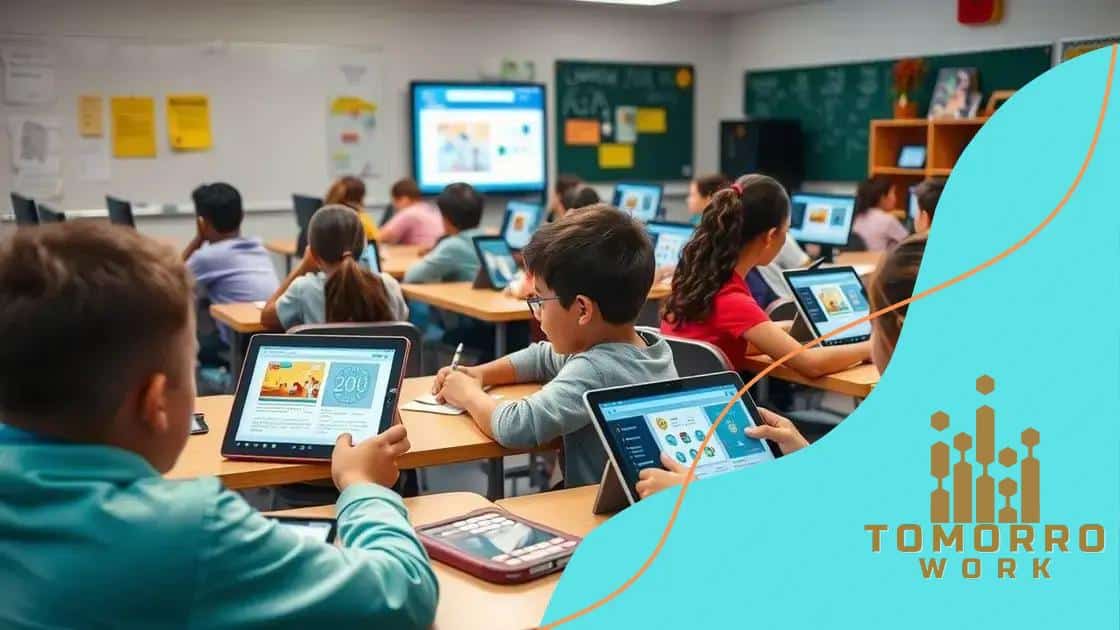Trends in digital tools for inclusive education

Advertisements
Trends in digital tools for inclusive education include personalized learning experiences, increased use of AI, and immersive technologies like VR and AR, all aimed at enhancing accessibility and engagement for diverse learners.
Trends in digital tools for inclusive education are shaping how students learn and engage. Imagine a classroom where every learner thrives, regardless of their background. Curious how technology plays a role in this transformation?
Advertisements
Understanding digital tools for inclusion
Understanding digital tools for inclusion is essential in today’s educational landscape. These tools help create an environment where every student can participate and thrive, regardless of their abilities.
What Are Digital Tools for Inclusion?
Digital tools for inclusion include technologies that facilitate learning for all students. They encompass various formats, including software, applications, and online resources designed to accommodate diverse learning needs. For example, assistive technologies can help students with disabilities engage better in their learning environment.
Benefits of Digital Tools for Inclusivity
Using digital tools can provide several advantages:
Advertisements
- Enhanced engagement from all students
- Opportunities for personalized learning experiences
- Improved accessibility for students with diverse needs
These benefits contribute to a more equitable classroom where every student feels valued and included. Moreover, teachers can better support their students by using these tools, which can help identify specific learning challenges.
Popular Digital Platforms for Inclusion
Many platforms focus on inclusive education. Some of the most widely used include:
- Learning management systems like Google Classroom
- Interactive learning tools like Kahoot!
- Resources tailored for students with disabilities, such as speech-to-text applications
These platforms make it easier for educators to adapt their teaching methods to meet a variety of learning styles and needs, ensuring that every student has the opportunity to succeed.
Challenges to Consider
Despite the advantages, there are challenges in implementing these tools. Issues such as the need for training, budget constraints, and varying levels of technological access can affect how effectively these tools are used. Schools and educators can mitigate these challenges by providing support and resources to ensure that both students and staff are comfortable with the technology available to them.
In conclusion, understanding digital tools for inclusion is vital for creating an educational space where all students can thrive. With these tools, educators can provide tailored support for students, enhancing their overall learning experience.
Key benefits of inclusive education tools
The key benefits of inclusive education tools are significant and transformative. These tools enhance learning experiences for all students, ensuring that everyone has the chance to succeed.
Improved Engagement
One major advantage is improved engagement among students. When learning tools are tailored to various needs, students become more interested and motivated to participate in lessons. Inclusive tools help to level the playing field, allowing all students to contribute, regardless of their abilities.
Personalized Learning
Another benefit is the ability to personalize education. Inclusive education tools enable teachers to adapt lessons to meet the unique requirements of each student. This means that lessons can be modified based on individual learning styles, which enhances understanding and retention of information.
- Adjustable lesson plans to fit diverse needs
- Access to varied learning materials
- Flexible assessments to measure progress effectively
Furthermore, these tools allow educators to track progress and provide timely feedback. This helps students understand their strengths and areas for improvement, fostering a culture of growth and resilience.
Enhanced Accessibility
Accessibility is yet another crucial benefit. Inclusive education tools ensure that all students can access learning materials and resources. This includes features like text-to-speech technology, interactive applications, and resources designed for students with disabilities.
All of these elements contribute to creating a supportive educational environment. When students feel included and valued, their confidence grows, leading to a more positive classroom atmosphere.
In summary, the key benefits of inclusive education tools span improved engagement, personalized learning experiences, and enhanced accessibility. These factors are essential for helping all learners thrive in academic settings.
Exploring popular digital platforms

Exploring popular digital platforms plays a crucial role in understanding how to implement inclusive education effectively. These platforms provide various tools that cater to the diverse needs of students in the classroom.
Learning Management Systems
Learning management systems (LMS) are widely used in educational settings. They allow teachers to create, manage, and deliver online courses. Some notable LMS include:
- Google Classroom
- Moodle
- Canvas
These systems help streamline communication between teachers and students and offer easy access to learning materials.
Interactive Learning Tools
Interactive tools like Kahoot! and Quizlet are essential for engaging students in a fun and interactive way. They allow for real-time participation and help reinforce classroom lessons. Using games and quizzes, teachers can assess students’ understanding in a lively environment.
Additionally, platforms such as Flipgrid encourage students to share their thoughts and ideas through videos. This helps build confidence and improves communication skills. Tools like these can be incredibly valuable in fostering an inclusive atmosphere.
Assistive Technologies
Assistive technology plays a vital role in supporting students with disabilities. Tools like Read&Write offer text-to-speech capabilities, while Speechify aids in reading comprehension. These resources enable students to engage with materials at their own pace, tailoring their learning experiences.
Many of these popular digital platforms take into consideration the varied learning requirements of students. By leveraging these resources, educators can create a more inclusive and engaging learning environment. As we continue to explore these tools, we can better understand their potential in transforming education.
Challenges in implementing digital inclusivity
Challenges in implementing digital inclusivity in education are significant, yet they offer opportunities for growth and improvement. Understanding these challenges is crucial for creating effective educational strategies.
Access to Technology
One of the biggest challenges is ensuring access to technology for all students. Not every student has the same access to computers or the internet. This digital divide can hinder the ability of some students to engage with inclusive education tools.
Teachers and schools need to find ways to provide necessary resources, such as:
- Affordable devices for every student
- Reliable internet access in underserved areas
- Community programs offering technology support
Training and Support
Another significant issue is the lack of training for educators on how to use these inclusive tools effectively. Teachers may feel overwhelmed by new technology or unsure of how to incorporate it into their lessons. This can lead to underutilization of valuable resources.
To tackle this, schools should focus on providing:
- Ongoing professional development for teachers
- Peer mentoring programs
- Access to online training resources
Support networks can foster confidence among teachers, encouraging them to embrace these tools.
Resistance to Change
Resistance to change can also be a barrier to implementing digital inclusivity. Some educators may prefer traditional teaching methods and be hesitant to adopt new technologies. This mindset can affect the overall success of inclusivity efforts in the classroom.
Awareness campaigns and showcasing success stories can help persuade skeptics. Demonstrating the impact of digital inclusivity on student learning can create a culture that embraces innovation.
Overall, while challenges exist in implementing digital inclusivity, the commitment to overcoming these obstacles can lead to a more equitable educational environment.
Future trends in educational technology
Future trends in educational technology promise to reshape how students learn and engage with educational content. As technology advances, educators can expect new tools and methods to enhance inclusivity and accessibility.
Personalized Learning Experiences
One major trend is the shift toward personalized learning experiences. Adaptive learning technologies can respond to individual student needs and preferences. This approach allows students to learn at their own pace according to their unique strengths and weaknesses.
Some key features of personalized learning include:
- Data-driven insights on student performance
- Customized learning paths and resources
- Flexible assessments to match learning styles
Increased Use of Artificial Intelligence
Artificial Intelligence (AI) will play a bigger role in education. AI tools can analyze student data to provide tailored feedback and identify areas needing improvement. This will help teachers focus their efforts where students need it most.
Additionally, AI-powered chatbots can assist students with questions outside of class hours. This increases engagement and ensures that students have access to assistance whenever they need it.
Virtual and Augmented Reality
Virtual and augmented reality (VR and AR) technologies will enhance learning by providing immersive experiences. Students can explore historical sites, conduct science experiments, or walk through complex systems in a virtual environment. This makes learning interactive and fun.
Benefits of using VR and AR in education include:
- Engaging students with realistic simulations
- Encouraging teamwork and collaboration
- Facilitating deeper understanding of complex concepts
Focus on Social-Emotional Learning
Future technology will also emphasize social-emotional learning (SEL). Platforms designed to support SEL can help students develop important skills like empathy, resilience, and communication. This focus is crucial for creating a well-rounded educational experience.
Incorporating SEL tools in education can lead to improved classroom dynamics, as students learn to connect with one another better and manage their emotions effectively. This trend highlights the importance of nurturing the whole child in educational contexts.
FAQ – Frequently Asked Questions about Trends in Digital Tools for Inclusive Education
What are digital tools for inclusive education?
Digital tools for inclusive education are technologies that support diverse learners, helping them engage and succeed in the classroom.
How do personalized learning experiences benefit students?
Personalized learning experiences allow students to learn at their own pace, catering to their individual strengths and needs.
What role does artificial intelligence play in education?
AI analyzes student data to provide tailored feedback, enhancing learning and helping teachers identify areas for improvement.
Why are social-emotional learning tools important?
Social-emotional learning tools help students develop interpersonal skills, promoting a supportive and positive classroom environment.





